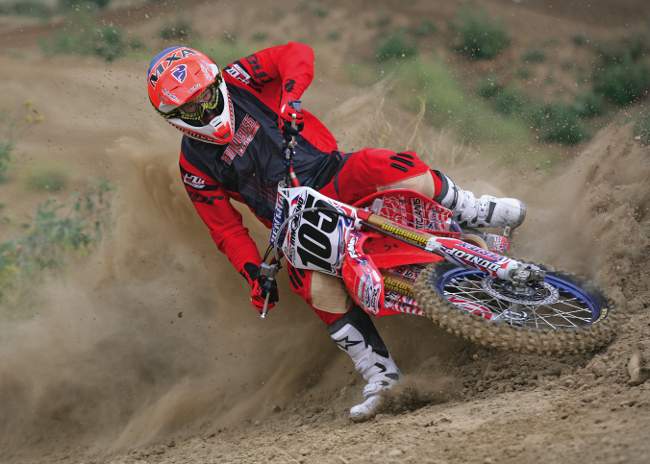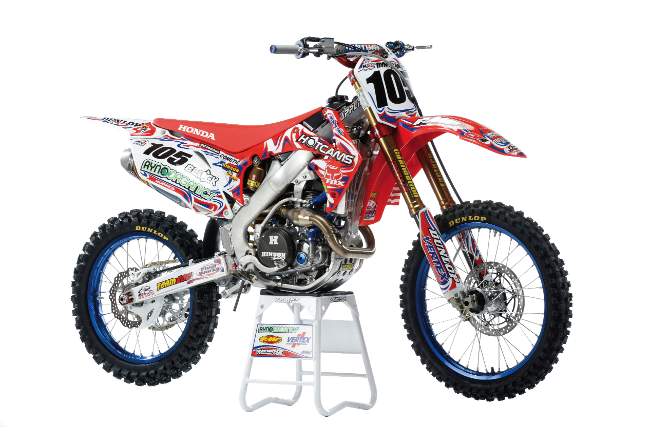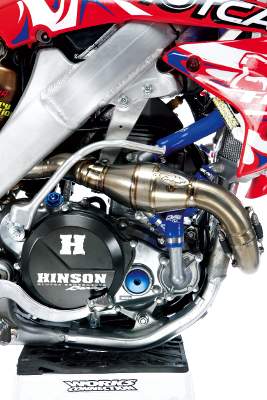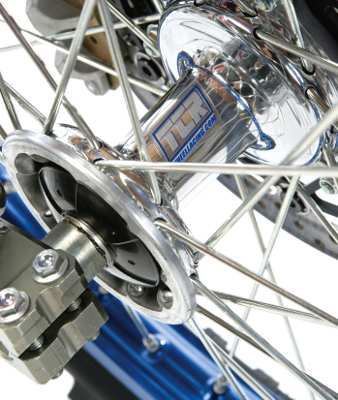WE RIDE RYAN HUGHES’ UNITED STATES GRAND PRIX HONDA CRF450 MOTOCROSS BIKE:

Ryan Hughes has always appreciated the FIM World Motocross Championships. His appreciation started when he was a little kid standing by the fence at the Carlsbad USGP cheering on the Americans, and it culminated in him representing his country as a member of the winning 2000 Motocross des Nations team and the second-place U.S.A. team in 2003. Before that, Ryan spent a year in Europe racing the GPs (finishing fourth overall in 1999).

The last time Ryan Hughes saw a United States Grand Prix was from behind his handlebars at the Budds Creek 250 Grand Prix in 1999. At that race, Hughes finished on the podium behind Stefan Everts and winner Kevin Windham. And that was the last time the Grand Prix circus came to the United Sates.
When Ryan Hughes heard that the FIM MX1/MX2 Grand Prix series was going to come to SoCal’s Glen Helen Raceway, he jumped at the chance to be there.
The Glen Helen GP was organized on short notice, and so was Ryan’s ride. With the help of his sponsors, Ryan built a special bike for the 2010 USGP. And, as icing on the cake, the MXA wrecking crew got to test Ryan’s bike the second he pulled off the track. When people heard that Ryno was going to race the USGP, they usually gave one of two responses. First, many people said, “Oh, he must be racing the World Vet Cup class.” No, Ryan Hughes is only 37 years old, and for the Vet Cup the age limit was 40. The second response was, “Great, I bet he can still beat a bunch of the top guys.”
In Saturday’s qualifying race, Ryan did beat a bunch of guys. Ryan finished seventh. It looked like he could be competitive, but things just didn’t go his way. Being rusty at the top level, and somewhat uncomfortable with his setup, Ryan struggled to a 17th-place finish the first moto.
Between the first and second motos, Ryan lowered the forks and increased the compression. He was happy with the new setup…until he got hit in the chest with a rock the size of a fist. Next, he overjumped one of the rollers after the finish line and his hand came off the bars. His body was thrown forward with so much force that his chest bowed the crossbar. Even a man with the strength of Ryno couldn’t save this one. His body continued to roll over the front fender, bruising his hip as he and the bike hit the deck. Remarkably, he jumped back to his feet ready to remount and race, but his rear brake was broken. Banged up and brakeless, Hughes decided to call it a day and pull into the pits. Coincidentally, Grant Langston and Sebastian Pourcel scored DNFs on the same lap. Hughes edged them out for 30th.
When we saw his bowed-in crossbar we asked, “What kind of chest protector do you wear?” Ryan’s reply was, “Skin.” Ryan Hughes was always known for his aggressive style, and that has made him hard on bikes.
The results were disappointing for Ryan, but the racing was still very exciting. When we saw his bowed-in crossbar we asked, “What kind of chest protector do you wear?” Ryan’s reply was, “Skin.” Ryan Hughes was always known for his aggressive style, and that has made him hard on bikes. Further examination of Hughes’ bike would clue us in to the fact that even though he has been retired for a few years, he hasn’t really mellowed out. We couldn’t wait to check it out and ride it.
SHOP TALK: PIECE BY PIECE

Thanks to a successful career and a good public image, Ryan Hughes was able to call in the chips when he needed a bike for the USGP at Glen Helen. FMF, Hot Cams, Tokyo Mods, Hinson, Factory Connection, TCR, Renthal and others heeded the call.
Ryan Hughes’ race bike was built to perform at a pro level but still maintain its reliability. It would have to withstand Hughes’ aggressive style. TeamECC.com (Escondido Cycle Center) got the ball rolling by supplying the CRF450 and helping with the spare parts. A stage-two Hot Cams camshaft was installed for more top-end power. Hot Cams also supplied the 9.48mm valve shim kit used in setting the valve clearance. A Vertex piston raised the compression to 13:1. Tokyo Mods ported the cylinder head and reprogrammed the ECU with their own fuel and ignition maps. Cometic gaskets were used on the top-end. FMF supplied an anodized RCT Factory 4.1 exhaust system with a titanium Megabomb header and mid-pipe. A quiet insert was used in the muffler to bring the decibels down to FIM standards. On the intake side was a DT1 air filter. The EFI throttle body was sent to Injectioneering. Their modification was designed to improve performance for the first quarter turn of the throttle and prevent flameout. Before the race, in testing and practice, Ryan used VP 4.4. He switched to special FIM spec gas for the U.S. Grand Prix.
For Glen Helen, Ryan selected a 14/51 gear combo. The rule of thumb states that one tooth on the front equals 2-1/2 on the rear. Therefore, Ryan’s gearing was equal to one-half tooth taller on the rear?if that were possible. Ryan feels that the CRF engine has more mechanical advantage with this gearing. Hinson Clutch Components gave Hughes’ bike the whole kit-and-kaboodle, including their six-spring inner hub and pressure plate (the sloppy four-spring stocker just doesn’t cut it), billet clutch basket, fibers, steels, springs and outer clutch cover.Works Connection provided the protective parts and cosmetic trickery. The bike had Works Connection’s radiator braces, skid plate, engine plugs, Elite Perch, front billet brake cover, rear billet brake cover, chain adjuster blocks and Factory II stand. The radiator braces could very well have saved Hughes’ bike from an early mechanical DNF. The braces were caved in on both sides. One side fell victim when Hughes laid the bike over so far in a turn that the shroud hooked on a rut and folded everything backward. The other side happened when he endoed. The CNC-machined, alumnum skid plate was also trick, with Works Connection’s RIMS (Rubber Isolator Mounting System). The idea is to have a skid plate that doesn’t interfere with the flexing of the bike’s frame. The Factory II stand had a custom modification. The top rivets on one side were replaced with screws, while shims were placed underneath the rubber?Ryan’s CRF sat level on the stand.

Ryan ran Dunlop mousse tubes in his USGP bike. Until you get used to them, they feel weird.
Suspension duties were handled by Factory Connection in the form of a revalved Showa A kit. Accommodating the larger-diameter fork tubes were bored-out, stock-offset Applied Racing triple clamps. The rear utilized Factory Connection’s longer shock linkage arm.
Ryan’s wheels were done by TCR. Troy Cardiel turned down and polished the stock hubs and anodized the stock rims. The wheels were mounted with Dunlop MX51 tires, a Dunlop super-heavy-duty tube in the front, and a Dunlop foam tire insert in the rear. These were actually the only unobtainable works parts on the bike. Dunlop doesn’t sell their Mousse-style inserts or their super-thick tubes. Flats are a concern at Glen Helen, as Ryan can attest, because he lost the World Four-Stroke Championship race earlier this year with a flat tire. Finally, a QTM 270mm oversized front disk kit was mounted on the front.

Ryan Hughes has started a new venture called Ryno Organics to go along with his training camps. It got top billing.
Other accessories on Ryno’s bike included a Renthal 997 TwinWall handlebar, now with a bowed-in crossbar; Renthal dual-compound grips; rear sprocket; and MX chain. CV4 supplied a blue silicone coolant hose kit, hour meter, Fuel Kool and fuel line heat wrap. The CV4 hour meter read 12.0 hours when the MXA wrecking crew took possession of Hughes’ CRF450. The Fuel Kool is a special insulating barrier that fit snugly underneath the gas tank to block heat. Even more interesting was that the fuel line heat wrap was actually around the clutch cable. No, this wasn’t done by a confused mechanic; the idea was to try to prolong the life of the cable.
LightSpeed provided wide platform titanium footpegs, and Fasst Company sent their rear brake clevis and rim lock spacers. Last but not least, DeCal Works designed and delivered a custom graphics kit for a professional look that showcases the sponsors.

TEST RIDE: HANG ON AND PRAY
The ergos of Hughes’ bike were mostly normal?with a couple of quirks. His levers were angled in slightly to maximize leverage at the fingertips. His kill switch was rotated forward to get it out of the way. His throttle play was tight to minimize wrist movement (he’s broken his wrist in the past).
Upon firing up Hughes’ CRF450, we noticed it was quiet. On the track, there was a noticeable lack of bark?but that doesn’t mean that it lacked bite. Ryno’s bike produced slow-revving power that pulled strongly up Glen Helen’s steep hills. Although it was kind of slow getting on the pipe, Hughes’ bike made beaucoup power on top?well past the point where the stocker must be shifted. Still, Hughes says he likes more low and mid power so he can ride a gear high, shift early and let the bike and suspension work freely.
Through medium bumps the suspension would stay up in the stroke, leaving plenty of travel to handle big stuff with ease. Ryan claims he likes to chopper the bike out a bit, so he can ride over the front.
Our faster test riders were surprised and enamored with the Showa A kit suspension, reporting that it was substantially better than modified stock components. Hughes’ suspension setup was plush and workable for the first part of the stroke and Supercross-stiff in the last part. This may seem like a recipe for extreme midstroke harshness, but it wasn’t too bad. For the slower test riders, it was difficult to use all the travel in the forks. Through medium bumps the suspension would stay up in the stroke, leaving plenty of travel to handle big stuff with ease. Ryan claims he likes to chopper the bike out a bit, so he can ride over the front. The forks were definitely stiffer than the rear, but in motion the bike was pretty balanced. Overall, Ryan’s bike was a solid ride with all the details taken care of and would make a solid workhorse for a fast privateer.
CONCLUSION: WHAT DO WE AND RYAN REALLY THINK?
 |
 |
| A little bling never hurt anyone, as long as it is attached to a full-race engine with an FMF pipe and Hinson clutch. | The TCR wheels start life as stock Honda CRF450 hubs, but are turned down and polished up. |
We asked Ryan how the 1999 Budds Creek USGP was compared to the 2010 Glen Helen USGP. He replied, “The high level of professionalism at the event was the same, but the infrastructure has grown. Also, they paid more attention to the quality of the track. They did a good job taking care of the riders with passes and stuff, but the purse and sign-up costs for the European riders is ridiculous. It’s like charging Kobe Bryant $1500 every time he plays a basketball game.”
Hughes retired from professional racing five years ago, but he hasn’t been sitting on the couch. Through the Ryno Institute, Hughes runs a motocross class, teaching riding techniques, nutrition, exercise and how to stay safe and healthy racing. Ryno hosts training, media and race events, and as if that weren’t enough, he has also launched Ryno Organics?a 100-percent organic food company.
Although you might think that the 2010 USGP was Ryan’s last race, don’t count on it. Ryan has plans to do motocross schools and races in Italy and Spain.
As for Ryan Hughes’ USGP bike, it was really cool to see a diverse group of companies come together to support an old soldier. They did it out of love for Ryan and a belief in how gnarly he still is.






Comments are closed.